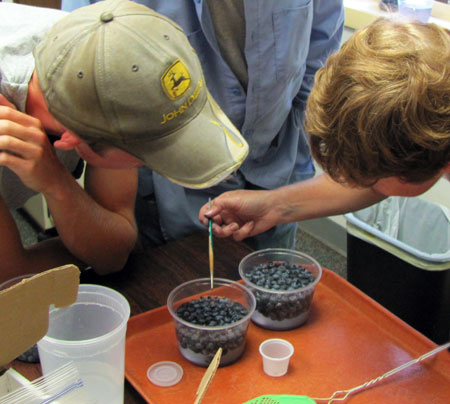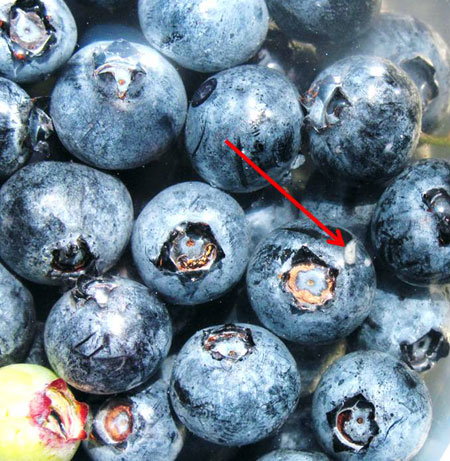Sampling harvested berries to detect spotted wing Drosophila larvae infestations
Minimize fruit losses from spotted wing Drosophila by separating infested from non-infested fruit loads. Follow simple fruit sampling methods to help minimize the amount of fruit diverted to juice and evaluate the effectiveness of pest control actions.
The 2012 fruit season has been a collection of adverse situations that include a damaging attack of spotted wing Drosophila (SWD) in all small fruit crops harvested In Michigan. Growers need to learn to deal with this insect until a suitable alternative for control is found. In the meantime, it is necessary to follow some guidelines already developed at Michigan State University and by other research teams from the West Coast to minimize crops losses. Some of the questions growers are asking are, “How do I know if my fruit is infested with SWD?” and “What do I do if my fruit is infested with SWD larvae?”
As we know, there is a zero tolerance for insects part established for processing blueberries that over the years has been applied to blueberry loads contaminated with Japanese beetles and blueberry maggots. Unfortunately, the presence of SWD larvae receives the same consideration than blueberry maggots. In other words, if a load is infested with worms it is immediately rejected and diverted for juice. This, of course, represents a substantial economic loss for the grower. We have seen this situation occurring several times during the current season. Also, growers need to realize that SWD larvae in fresh or processing berries are also a food safety risk.
One of the main problems to determine what to do in case of larval infestation at harvest time is that we do not know the spatial distribution of the pest in the field. Although we have information for the spatial distribution and movement for other flies like blueberry maggots, we know very little about the SWD distribution under field conditions. Because of this lack of information, we can’t assume that if we find fruit infested in one sector of the field the entire field is infested. Therefore, growers need to asses each lot individually for the presence of SWD larvae before delivering the berries to the processor. This assessment will allow that only infested lots will be diverted for juice.
For raspberry growers, the recommendation is the following. Since we are in the middle of the harvest, the efficacy of the current pest control actions need to be evaluated not only be checking the presence of adults in bait traps, but also by checking the fruit for the presence of larvae. In this manner, insecticide applications will be done only when they are needed. This, in turn, will avoid unnecessary applications and will prevent the SWD development of resistance to insecticides.
Several inspection methods have been proposed to evaluate the presence of SWD larvae in harvested berries, blueberries, raspberries, etc. Two good guides for detecting SWD larvae in fruit samples are available online: Spotted Wing Drosophila (SWD) Monitoring, Identifying, and Fruit Sampling by the small fruit team from Washington State University and Spotted Wing Drosophila Management Recommendations for Michigan Raspberry and Blackberry Growers by the MSU Extension small fruit team.
So far, the most effective method for a rapid determination of the presence of larvae in fresh blueberries or raspberries and in other berries is the use of a salt solution made up dissolving 1 to 2 Tsps. of salt in 1 cup of water. Suspect berries are submerged on the salt solution for about 10 to 15 minutes. If larvae are present in the fruit, they will start leaving the berry through egglaying holes. SWD larvae will be visible emerging from the berries and will be visible without the help of hand lenses.
Pictures below illustrate this technique. Arrows in the pictures show SWD larvae crawling out of the berries a few minutes after the berries were submerged in the salt solution.
Blueberry fruit sampling using a salt solution (Photo credits: Carlos Garcia, MSUE)



Raspberry fruit sampling with salt solution (Photo credit: Carlos Garcia, MSUE)




 Print
Print Email
Email



